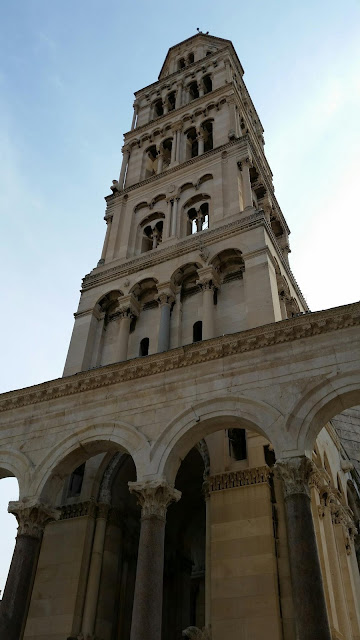Diocletian was a Roman Emperor in the late 3rd century. He followed a series of bad emperors who were often killed within a few years. He did not want that to happen to him, so he set up the government into two sections and split the empire into the east and west in the process. He took over the Eastern Roman Empire and from there worked to improve the infrastucture. However, he never planned to die as emperor, so he began planning his retirement and in 293 began construction of a walled palace in Split. It took 10 years to build and he only lived in the palace for 11 years before he died at the age of 71.
As many of the Roman emperors, Diocletian considered himself the son of the Roman god, Jupiter. Because of that, he was treated as a god in his palace. He was carried around by servants and often went out to the Peristil (below) to "allow" the slaves in the palace to worship him by lying on the ground and not looking him in the eyes in case his "divine beauty" would be too much for them to handle.
The substructure of the palace was flooded for more than a thousand years and was not discovered until an Allied bomb was dropped on top of the palace during World War II. It opened the area that had been lost to history. The ceiling of the substructure had been broken in the time of the Romans and the Middle Ages for use as a sewer. The filled holes can be seen in the ceiling. There are several layers of waste that provided archaeologists with details about life in the palace. Once discovered, it took more than 30 years to clean. Even then, I did not touch the walls as I walked through!
The entrance to the Peristil was a rounded room with arches and an open air dome "skylight" that created perfect acoustics. Below, you can see the open ceiling and the doorway where the emperor stood to be worshipped.
When Diocletian died, he had a mausoleum built for his burial. It was an octogonal structure in the center of the palace. It included marble arches across the front that served no purposed other than decoration and he included sphinxes that had been taken from Luxor, Egypt. However, once he died, the palace was abandoned as it had no strategic value to the Romans.
Hundreds of years later, the barbarians invaded the area north of Split. The barbarians did not know about the palace, but those who had been Romans did and they used it to their advantage! They migrated south and inhabited the palace. Many of the buildings were demolished and new buildings were built in their place until the palace became a medieval city.
The people in this time had mostly become Christians. Diocletian was widely know to oppose (often with death and torture) the Christian religion. So, when they took over his palace, they had no trouble removing Diocletian's body and building the oldest continuously used cathedral using the mausoleum as the beginning of the structure.
Below is the bell tower of the cathedral, the decorative arches, and a sphinx from the exterior of the cathedral.
Bonus: Remember the substructure of the palace?
In season 4 of Game of Thrones, this same room was used in the scene when the dragons were locked beneath the city because they had become a danger! (Below)
Image is copyrighted by HBO









Cool!!!
ReplyDelete